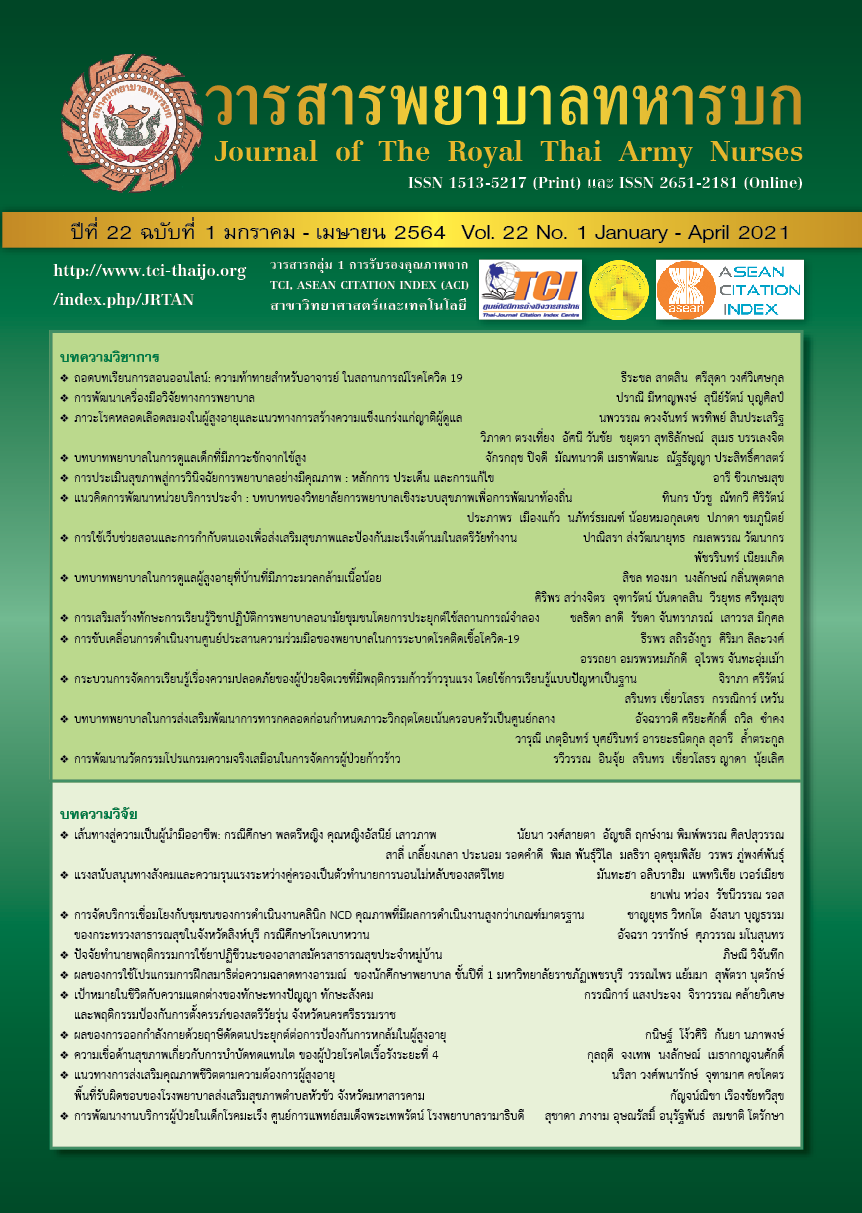The Development of a Clinical Supervision Model for Isolation Precaution of Antimicrobial Resistance at Neurological Surgery Department, Sunpasitthiprasong Hospital
Keywords:
Clinical Supervision Model, isolation precaution of Antimicrobial ResistanceAbstract
The purposes of this research and development study were: 1) to develop a clinical supervision model for isolation precaution of antimicrobial resistance at neurological surgery department, Sunpasitthiprasong hospital, and 2) to evaluate the developed clinical supervision model on head nurses knowledge, nursing competency and the registered nurses’ perceptions. The samples were composed of 2 groups. The discussion group in the developmental stage included 3 head nurses and 6 registered nurses. The second group who evaluated the developed clinical supervision model included 6 head nurses and randomized samples of 52 registered nurses from the Neurological Surgery Department. The experimental tools were composed of: 1) focus group question and the developed clinical supervision model. 2) The data collection tools composed the clinical supervision knowledge test, competency evaluation form, and the questionnaire for perception of clinical supervision. All research tools were validated for content by 5 experts. The content validity indexes of these tools were 0.88, 1.00 and 1.00. The reliability (KR-20) of the clinical supervision knowledge test was 0.75. The Cronbach’s alpha reliability coefficient of the competency evaluation form and the questionnaire for perception of clinical supervision results were 0.94 and 0.83. Data was analyzed by descriptive statistics, content analysis, and Wilcoxon matched-pairs signed-ranks test.
The results are as follows. 1) The developed clinical supervision model based on the three functions Proctor’s model. 2) knowledge of head nurses significantly higher than before receiving. (p< .05). Competency of registered nurses significantly higher than before receiving. (p< .001), and perceptions of supervision at the good level.
Downloads
References
National Antimicrobial Resistance Surveillance Center; 2018.
Pumak p., Pota P., et al. Health and economic impacts of antimicrobial resistance (AMR) in Thailand. Health Systems Research Institute (HSRI). 2012; 3 (6): 352-360. (in Thai)
Pengsawat V. Research and Development. Sakon Nakhon Rajabhat University Journal. 2009; 1(2). (in Thai)
Proctor, B. Training for the supervision alliance from: Routledge Handbook of Clinical Supervision, 2011 Fundamental International Themes Routledge; 2016.
Homnan, N. The Development of Preventive Emergency Obstetric Clinical Supervision Model For Nurses. Journal of The Royal Thai Army Nurses. 2017; 18 (Supplement): 140-148. (in Thai)
Chomsiri, A. The Development of Nursing Supervision Program Model for Head Nurses in Kuchinarai Crown Prince Hospital [Thesis]. Chonburi: Burapa University; 2012. (in Thai)
Kumraj, T. The Development System for Excellence in Nursing Supervision at Fort Sunpasitthiprasong Hospital Warinchamrab District, UbonRatchathani Provice. Journal of The Royal Thai Army Nurses. 2012; 13(3): 60-71. (in Thai)
Sangumphi, K. Effect of Clinical Supervision on Nurse Knowledge, Capabilities in Pain Mamagement of Postoparative Patient and Satisfation [Thesis]. Pathumthani; Rangsit University; 2009. (in Thai)
Eiumargaht, D. Effect of The Use of Clinical Nursing Supervision of Head Nurse that Integrated Collaboration Concepts on Perceived Nursing Outcome as Reported by Professional Nurses. [Thesis].Bangkok; Saint Louis College; 2010. (in Thai)
Faul, F., Erdfelder, E., Buchner, A., & Lang, A.-G. Statistical power analyses using G*Power 3.1: Tests for correlation and regression analyses. Behavior Research Methods. 2009; 41: 1149-1160.
Downloads
Published
How to Cite
Issue
Section
License
บทความหรือข้อคิดเห็นใดใดที่ปรากฏในวารสารพยาบาลทหารบกเป็นวรรณกรรมของผู้เขียน ซึ่งบรรณาธิการหรือสมาคมพยาบาลทหารบก ไม่จำเป็นต้องเห็นด้วย
บทความที่ได้รับการตีพิมพ์เป็นลิขสิทธิ์ของวารสารพยาบาลทหารบก
The ideas and opinions expressed in the Journal of The Royal Thai Army Nurses are those of the authors and not necessarily those
of the editor or Royal Thai Army Nurses Association.






